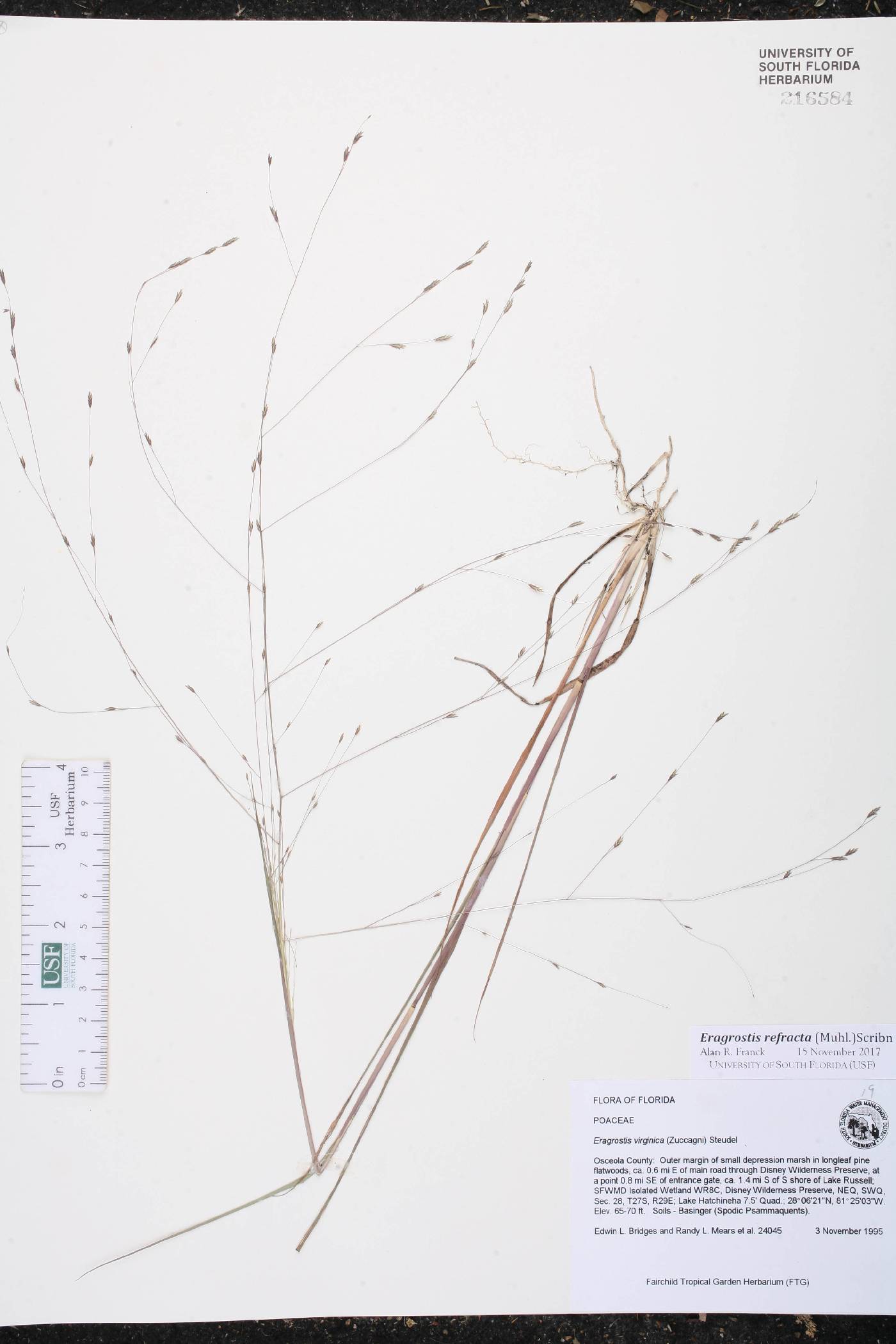|
|
|
|
Family: Poaceae
coastal lovegrass
[Eragrostis acuta Hitchc., moreEragrostis campestris Trin., Eragrostis virginica (Zuccagni) Steud., Poa amabilis Roem. & Schult., pro syn., Poa pectinacea var. refracta (Muhl.) Chapm., Poa refracta Muhl., Poa virginica Zuccagni] |
Plants perennial; cespitose, with innovations, without rhizomes, not glandular. Culms 30-85(110) cm, glabrous and shiny below the nodes. Sheaths sparsely hairy at the apices, hairs to 6 mm; ligules 0.1-0.4 mm; blades 10-35 cm long, 2-5 mm wide, flat to involute, glabrous abaxially, scabridulous and sparsely pilose adaxially, hairs to 7 mm. Panicles (25)30-60 cm long, 25-40 cm wide, broadly ovate to obovate, open, diffuse; primary branches 5-25 cm, diverging 20-90° from the rachises, capillary; pulvini hairy or glabrous; pedicels 0.5-25 mm, appressed, only the terminal pedicels on each branch longer than the spikelets. Spikelets 4-18(23) mm long, 1.4-3.4 mm wide, linear-lanceolate, grayish-green or stramineous to purplish, with (4)9-30 florets; disarticulation tardy, basipetal, in the rachillas below the florets, glumes persistent. Glumes narrowly lanceolate, membranous; lower glumes 0.8-2.4 mm; upper glumes 1.5-2.6 mm; lemmas 1.4-2.8 mm, lanceolate, membranous, apices acute to acuminate; paleas 1-2.6 mm, hyaline to membranous, narrower than the lemmas, apices obtuse to acute; anthers 2, 0.3-0.5 mm, purplish or brownish. Caryopses 0.5-0.9 mm, ovoid to ellipsoid, finely striate, reddish-brown. 2n = 28. Eragrostis refracta grows in sandy pinelands, savannahs, marshes, and woodlands on the coastal plain of the southeastern United States, at 0-150 m. It is not known from Mexico. Erect, slender, tufted perennial 4-8 dm; lvs mostly crowded near the base, the blades elongate, 2-5 mm wide, tapering to a fine point; infl ovoid, two-thirds as long as the whole shoot, the scabrous branches pilose in the axils, spreading or eventually reflexed, with relatively few, scattered spikelets in the distal half; spikelets 5-16 mm, 10-28-fld, often purplish, short-pediceled, strongly ascending or appressed to the branches; first glume 0.9-1.7 mm, the second 1.4-1.8 mm; lemmas 1.6-1.9 mm, compressed-keeled and evidently 3-veined, persistent, the rachilla eventually fragmenting; grain 0.5-0.9 mm, half as thick. Moist or wet, sandy or muddy soil along the coast; Del. to Fla. and Tex. Gleason, Henry A. & Cronquist, Arthur J. 1991. Manual of vascular plants of northeastern United States and adjacent Canada. lxxv + 910 pp. ©The New York Botanical Garden. All rights reserved. Used by permission. |



